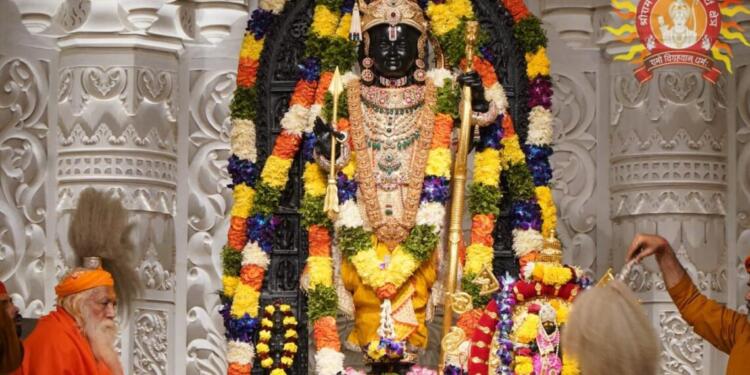The revered Ram Mandir in Ayodhya is celebrating the first anniversary of Shri Ram Lalla’s Pran Pratishtha (consecration) today, January 11, as “Pratishtha Dwadasi.” On this momentous occasion, Chief Minister Yogi Adityanath performed Abhisheka (the sacred anointing) of Shri Ram Lalla in the sanctum sanctorum. Today, we are addressing those usual suspects and naysayers who launch tirade against Hindus and question the necessity of Mandir reclamation, brazenly arguing that building Mandirs is a waste of government resources. Pertinently, the Ram Mandir and temple centric enterprises not just spur economic growth but also empower women.
Temples have long been considered only religious destinations undermining its economic perspective. Through religious tourism, temples open up new employment opportunities for women.
Ram Mandir and Economy
Since the inauguration of the Ram Mandir, devotees have been thronging the streets of Ayodhya to seek darshan of Balak Ram. About 130 million pilgrims have visited Ayodhya in one year, with more than 40 million of them offering reverance to Shri Ram Lalla. This large influx of visitors has brought about a dramatic transformation in religious tourism in Ayodhya.
Keeping in view with the large influx of devotees, 1,200 new hotels and restaurants have come up in Ayodhya, which have greatly helped local businesses and entrepreneurs. The trade of prasad has increased by 500 times, and the flower business has seen a tremendous boom. Solar energy usage has also increased in places around the Ram Mandir, lighting up major city roads.
The Ram Mandir has not only changed the business sector but has also opened up a lot of opportunities for local women. For instance, Sangeeta Pandey, an entrepreneur from Gorakhpur, prepared 5,100 prasad boxes, providing employment to local women. Besides the profound religious significance, such changes reflect how the Mandir has also emerged as a significant source of economic independence and empowerment for women.
Empowered Women and a Strong Economy
Many temples in India have taken significant steps toward women’s empowerment. For example, the famous Sri Padmanabhaswamy Temple in Kerala has provided women with opportunities in handicrafts and artwork businesses. Local women work in the temple-related shops and markets, which promotes their economic development. Similarly, the Meenakshi Temple in Tamil Nadu has encouraged women to participate in religious events and rituals, improving their social and economic standing.
While compiling a non-exhaustive list seems to be an excercise in futility, here are a few examples to highlight the obvious: how temples have contributed to both the empowerment of women and the strengthening of India’s economy.
| S. No. | Place | Temple Name | Description |
|---|---|---|---|
| 1 | Amritsar, Punjab | Pushpa Punya | 70 women from Jethunangal create incense sticks and cones from temple floral waste, promoting sustainability and jobs. |
| 2 | Uttarakhand | Kedarnath Temple | 20 SHGs manufacture and supply sweets and prasad, enhancing livelihoods. |
| 3 | Karauli, Rajasthan | Kaila Maa | Green bangles sold as prasad provide jobs to 5000 people. |
| 4 | Ujjain, Madhya Pradesh | Mahalakaleshwar Temple | 16 women process floral waste into products, earning up to ₹10,000/month. |
| 5 | Tirupati, Andhra Pradesh | Tirumala Mandir | 150 women upcycle floral waste into incense, using eco-friendly materials. |
| 6 | Tripura | Tripureswari Temple | Women produce milk for Matabari Peda, supporting traditional delicacies. |
| 7 | Delhi | – | 3000 women recycle temple flowers into eco-friendly products. |
| 8 | Ayodhya, Uttar Pradesh | – | Female entrepreneur prepared 5100 special prasad boxes for a religious event. |
| 9 | Sambalpur, Uttar Pradesh | Samaleswari Temple | Women make incense sticks from temple flowers under the brand Juhar. |
| 10 | Barabanki, Uttar Pradesh | Raam Temple | Women craft MDF wood 3D models of temples for employment. |
| 11 | Nainital, Uttarakhand | Naina Devi Temple | Women create designs on clothes using temple flowers, promoting local culture. |
| 12 | Satna, Madhya Pradesh | Mahakal Lok Temple | 200 women manage temple security, increasing tourist footfall. |
| 13 | Varanasi, Uttar Pradesh | Kashi Vishwanath Temple | SHGs make millet-based prasad, enhancing livelihoods and health. |
| 14 | Gaya, Bihar | Bodhgaya Temple | Women convert floral waste into dyes, supporting Khadi sales. |
| 15 | Uttarakhand | Jageshwar Temple | Women develop new prasad varieties using local ingredients, enhancing livelihoods. |































